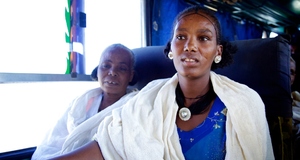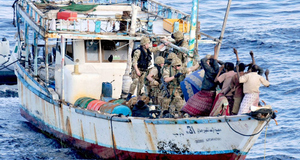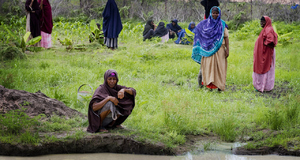Featured Article:The Horn of Africa: Critical Analysis of Conflict Management and Strategies for Success in the Horn's FutureIndependence and Rising ConflictBritish and Italian Somalilands gained independence the summer of 1960 and formed the Somali Republic. Newly united inhabitants shared the general hope that Somalis living under Ethiopian rule would soon join them once the past fluctuation of the region’s provisional boundary was resolved. However, Ethiopia was not willing to offer Somalia control of the region. Unexpectedly rebuffed, irregular Somali guerillas began harassing residents of the Ogaden. The guerillas’ numbers steadily rose until Ethiopia sent its army in October 1963, causing the conflict to evolve into conventional war until a ceasefire was called in April 1964. The United States became the principal source of external support to Ethiopia as early as 1950. Still, the United States attempted to provide economic and military aid to Somalia during the Ogaden conflict in an effort to undermine Soviet influence.In 1963, the United States, Italy, and Germany offered a $10million package to Somalia to build its conventional army in order to face large Ethiopian armed forces. However, Somalia was not persuaded to reject its treaty of friendship with Russia for so meager an offer, and contracted Soviet military aid for three times the sum. Bargaining with Cold War superpowers became typical in the region, and eventually contributed to alliance swapping that directly resulted in continued regional conflict through endless arms supplies. At the same time, Eritrea, which had been an Italian colony from 1882 to 1941, was federated with Ethiopia from 1952 to 1962. It was then that the emperor of Ethiopia “made the great tactical error of abolishing [Eritrea’s] privileged status” by dissolving its parliament and annexing the country. Eritrea adamantly refused to forfeit its autonomy and broke out in revolt, “led by a number of faction-ridden but highly effective Marxist movements” that would last for 30 years, between the years 1961-1991, before gaining independence from Ethiopia (1985 p. 78). Djibouti continued under French Rule, to the chagrin of the Somalis who had expected it to join their new nation state. Unlike the Ogaden, Djibouti was a part of the Ethiopian economy. However, it had little chance of being joined with Ethiopia since it had never been under Ethiopian rule. Ethiopian interests were therefore served, along with those of the French, by staving off the Somali claim. The French refusal of a union with the other Somalis kept the colony from being absorbed by Somalia. In 1967, the colony became the French Territory of the Afars and Issas before attaining its independence as the Republic of Djibouti in 1977. Many Third World nations, once receiving independence from colonial rule, continue to be influenced by a stronger party. This is true in the Horn as well, but colonial powers were replaced by the United States and Soviet Union. This is important because superpower influence and East-West rivalry kept military stocks in endless supply, allowing rising conflicts to develop into crises that would continue far longer than they would have been able to otherwise. The Cold War and East-West InterventionThe competition between the United States and the Soviet Union in the Horn of Africa helped destroy international credibility in conflict mediation; instead of lending their influence for resolution, they used it to perpetuate conflict to continue their interests in a geostrategic location. Their presence funded wars that would have otherwise been unable to continue. This funding additionally propped up dictatorial regimes that were guilty of horrific crimes against humanity, and led to the eventual collapse of Somalia and its armament of dozens of militias. The entire region was important to the United States and Soviet Union, particularly before the age of satellites, for its location. Additionally, Somalia’s extensive coastline allowed for port development opportunities to the East and the Indian Ocean. An alliance with Ethiopia provided a regional power base with opportunities for internal economic/political cooperation. Both Ethiopia and Somalia had reason to make strong allies of world superpowers. Ethiopia desired regional hegemony, and its “size, military strength, and geographic position would make it the dominant state… [but] underdevelopment and tenuous national unity kept this role out of its reach” (1985 p. 82). Somalia desired control of the Ogaden region, but could not do so without matching Ethiopia’s conventional army. Before the United States and Soviet Union left the region, they each intervened in both countries and dramatically reversed alliances mid-conflict. The United States initially aligned itself with Ethiopia, which retained control of Eritrea where the U.S. had a base for strategic global military communications. When conflict erupted between Ethiopia and Eritrea, Washington pressured Ethiopia’s leadership against using an untrained peasant militia in Eritrea. In a subsequent slaughter of Eritreans, Ethiopia was rendered ineligible for military aid when the Carter administration placed Ethiopia on a list of human rights violators. United States arms shipments to Ethiopia were suspended just as the nation was running out of ammunition in its struggles against Eritrean and Somali insurgents. Therefore, to continue fighting Eritrea and Somalia, Ethiopia needed military aid. Since arms were no longer provided by the United States or other western powers, Ethiopia turned to communist nations. The Soviets, recognizing the benefits of allying with Ethiopia, brokered a $1 billion arms deal and signed a treaty of friendship with Ethiopia. Simultaneously the Soviet Union continued their presence in Somalia. This transition of alliances briefly afforded the Soviet Union friendly relations with both nations, providing an opportunity for conflict management. This is evident when, in 1977, both sides were so low on military supplies that a stalemate would have resulted if arms providers had refused to continue stocking the region. Instead, Russia exacerbated the conflict when it signed a treaty with Ethiopia, swapped alliances, and instigated continued arms build-up. Meanwhile, the United States had lost its influence in the region and was left to the sidelines as an ineffective bystander. The war in the Ogaden is representative of conflicts that require mutually painful stalemates before bilateral solutions are considered conceivable. During the Ogaden conflict, Somali leadership ambiguously defined success against Ethiopia, and overextended Somalia’s means, which drew out the conflict. This resulted in a stalemate, but not as intolerable to Ethiopia as it was to Somalia. The continued military funding by the U.S. and Soviet Union provided each side the resources to continue, and a conclusion could not be reached. In the midst of conflicting East-West interests, tumultuous civil environments emerged. Newly independent states struggled with their identity and the result was violent opposition to emerging political ideologies. Power struggles in every nation of the Horn are responsible for regional volatility and hundreds of thousands of deaths, as highlighted below.Continued on Next Page » Suggested Reading from Inquiries Journal
Inquiries Journal provides undergraduate and graduate students around the world a platform for the wide dissemination of academic work over a range of core disciplines. Representing the work of students from hundreds of institutions around the globe, Inquiries Journal's large database of academic articles is completely free. Learn more | Blog | Submit Latest in International Affairs |


















